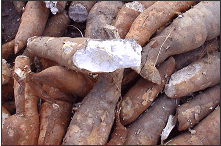February 8, 2006
Toyota Tsusho Corporation
Tokyo Electric Power Company, Inc.
Toyota Tsusho Corporation (Head Office: Nakamura-ku, Nagoya; President:
Junzo Shimizu) and Tokyo Electric Power Company, Inc.(TEPCO; Head Office:
Chiyoda-ku, Tokyo; President: Tsunehisa Katsumata) agreed to invest and
participate in Cassava Waste to Energy Co., Ltd. (hereinafter referred
to as "CWTE"), an operating company, established by the Clean Energy
Development Co. (Thailand) Ltd., of a project to recover methane from a
tapioca starch factory in Kalasin Province, Northeast Thailand. Construction
of the project facilities began today.
Cassava[*1], the raw material used in tapioca starch production, is widely
grown in Thailand, where it is the second most important agricultural
product. Tapioca starch factories, however, produce organic wastewater
that releases methane[*2]. With no legal restrictions on these emissions,
this methane has been released to the atmosphere up to now.
In this project, CWTE will build methane recovery equipments, digesters
and other facilities. Methane will be recovered as biogas and sold back
to the factory instead of going into the atmosphere. This will enable
significant reductions in factory emissions of methane as well as in the
amount of heavy oil currently used as boiler fuel for the factory.
Toyota Tsusho and TEPCO, moreover, have reached a basic agreement with
the CWTE to purchase carbon credits from this project. In the six years
from December 2006 to December 2012, the credits they purchase are expected
to reach approximately the equivalent of 600,000 tons CO2 (360,000 tons
for Toyota Tsusho, 240,000 tons for TEPCO). The two companies expect that
this project will be approved as a Clean Development Mechanism (CDM)[*3]
project under the Kyoto Protocol.
Toyota Tsusho and TEPCO have previously taken proactive initiatives to
reduce greenhouse gases in Japan and abroad through carbon credit purchases
and other means, but the new project marks as the companies' first direct
investment and participation in a CDM project operator.
Toyota Tsusho considers the environment as one of its main fields of
endeavor and believes that promoting its environmental businesses will
contribute to building a sustainable society. The company looks forward
to greater involvement in recycling and in products designed to reduce
global warming and protect the environment.
At TEPCO, taking steps to help prevent global warming has become one of
the management's most important priorities. As such, TEPCO continues to
promote global warming countermeasures in Japan and abroad. These include
electricity supply-side and demand-side initiatives in Japan and the
acquisition of carbon credits made available through overseas project
cooperation.
[*1] Cassava
 |
A perennial shrub native to Latin America. It grows well in unhealthy
land and acidic soils and is widely cultivated in Thailand. Cassava
tolerates dry conditions. It is easy to propagate in tropical climates,
needing only to have a stem planted in the soil. The long, thin root
grows fleshy to the length of 30 - 80cm. High-quality tapioca starch
is made by mashing the root and allowing it to precipitate.
[*2] Methane (CH
4)
Methane is a chemical emitted during fermentation of organic wastewater
released in the process of making tapioca starch from cassava.
Methane has 21 times the greenhouse effect of CO
2, and thus burning
methane and decomposing it into CO
2 and water can greatly reduce greenhouse
gases.
[*3] CDM (
Clean
Development
Mechanism)
A system under which industrialized nations and transitional economy
nations perform projects to reduce emissions (or increase carbon absorption)
of greenhouse gases in industrializing nations. The resulting emissions
reductions are acquired by the industrialized nation or transitional
economy nation in the form of carbon credits. The CDM is one of the
three Kyoto Mechanisms, which also include
Joint
Implementation (JI),
in which carbon credits are acquired from projects to reduce emissions
(or increase carbon absorption) of greenhouse gases in industrialized
nations and transitional economy nations, and
Emissions
Trading (ET),
in which industrialized nations and transitional economy nations trade
emissions credits under their respective emissions caps.
The Kyoto Mechanisms are economic mechanisms established in the Kyoto
Protocol in 1997. They are intended to add flexibility for making
greenhouse gas reductions.

Attachment